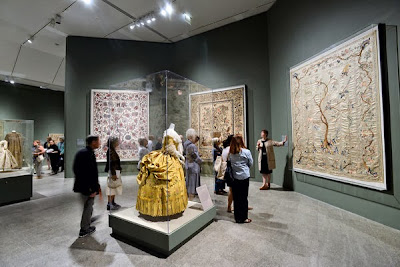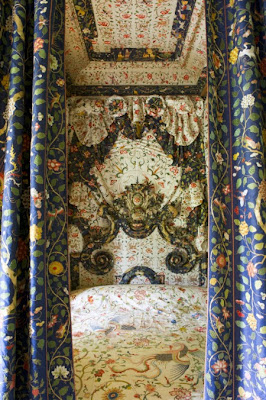I blame Paula Rubenstein. In early September, I popped into her eponymous (and revered) antiques store on New York's Bond Street. {www.paularubenstein.com}
By chance, Paula was there and so we started talking. Recognising a travel lover in each other, we began chatting about New York, London, antiques, Australia, books, and other beautiful things.
By chance, Paula was there and so we started talking. Recognising a travel lover in each other, we began chatting about New York, London, antiques, Australia, books, and other beautiful things.
And then we got onto the subject of fabric.
You can always tell another fabric addict.
They get that glazed look in their eyes when they're discussing cloth, and colour, and dye.
Paula is so au fait with fabric that she can often recognise where a certain cloth comes from in the world, simply by its weave/texture, colour and pattern.
(Hard to believe, I know, but I tested her with three random panels picked from dozens in the store, and she was only wrong once: it was very impressive.)
Paula specializes in American textiles from the 19th and 20th centuries, but it was the Indian fabrics that did me in. They were extraordinary. Rich hues of blue so intense you could have almost pushed your hand in and felt the warm swirl of the water in the dyebath.
I was so mesmerised that I left the store with a 100-year-old skirt from a desert tribeswoman in India.
(I love it that the word indigo is derived from a Greek term that means “from India.”.)
The vintage piece now hangs in our sunroom, with the rest of our 'summer blues', and I look at it daily and wonder who wore it? How hard was their life?
It has since inspired me to try and do a textile trip to India in 2014.
(There are many tours online if you're interested).
Coincidently – or should that be fortuitously? – New York's Met Museum was also having a textile exhibition at the same time we were there.
Interwoven Globe: The Worldwide Textile Trade 1500–1800 (on show until Jan 5, 2014) is first major exhibition to explore design from the 16th to the early 19th century through the medium of textiles, and shows how the international trade in early textiles influenced design across the world.
Look at these panels. Aren't they amazing?
If you can't make it to Manhattan, the website is just as interesting – link here.
Or you can purchase the hardcover 360-page exhibition catalogue, which should be on Amazon.
If you're interested in The Met's fabric archives, there's a wealth of information online link here
{Some of the V&A's textile collection is also online – link here}
London too, was a force of fabric this year.
The V&A has recently opened a new building in West Kensington to house its extensive archives, including its collection of fabrics. But it was SoHo I headed for. And a tiny place called The Cloth House.
The Cloth House, for fans of fabric, is a bijou bolthole (sorry, bad pun) of beauty. As a friend says: you can't imagine a fabric store can be this lovely.
I bought some more of this cobalt-blue vintage linen (used on our ottoman, above).
You've never felt such a sublime piece of linen.
{47 Berwick Street, London. www.clothhouse.com}
Then an English friend who also loves fabric introduced me to Trish Allen's sublime blog, Trouvais {trouvais.com or link here}, which features a great many vintage French textiles – including gorgeous antique French linens.
{Trish is also a gifted gardener and her knowledge of roses is incredible. So too is her garden.}
Through Trish (and the magic of blogs), I connected with Wendy Lewis of The Textile Trunk {link}, and stared, wide-eyed, while reading the story of Wendy's incredible purchase of a periwinkle blue Ciel de Lit antique French bed canopy, above. (Wendy carried this home on the plane rather than risking shipping it. That's dedication to fabric.)
There's a wonderful interview that Trisha did with Wendy here.
Wendy has a huge collection of vintage textiles for sale, including linens and toiles, but the most beautiful pieces are the antique toiles. Just see if you can resist.
NB: If you love toile, there's a Toile Museum in France. {Link here}
This museum is primarily devoted to the former printed textile factory founded in Jouy-en-Josas by Christophe-Philippe Oberkampf. There are extensive collections of Toile de Jouy ('Indian' textiles and fabrics with figure scenes), printing equipment, and old drawings, as well as the manufacturer's family's 18th-century furniture, objects and even their wardrobes. You can also see the general collections of French and foreign printed fabrics that were in vogue in the eighteenth and nineteenth centuries.
And if you collect antique and vintage textiles (which are increasingly valuable), two more sellers are:
Morgaine Le Fay Antique Textiles – link here {beautiful linens}
Katharine Pole {Link here} {more beautiful stuff}
In London, I bought the book, Indigo: The Colour That Changed The World.
It's sublime. Just sublime.
Who would have thought fabric manufacturing could be so interesting?
And so for all the fabric lovers out there, I thought I'd post a few (more) lovely textile links.
Happy fabric hunting.
"I'm a little bit of a fabric lunatic." – John Malkovich
{Who knew?}
A lovely story on the Lake Como silk industry, by the always-interesting Smithsonian magazine. {link}
(Lake Como is where Giorgio Armani and many other Italian design houses source their fabrics and indeed have their outlet stores.)
London-based textile designer Carolyn Quartermaine is still producing her gorgeous script silks, which seem to come out in ever-more stunning colours each year.
Carolyn now sells them from her Riviera home direct to the public. (To use a gauche retail term.)
I've just written a story for Gourmet Traveller magazine on the South of France, and was reminded of this when going through the photographs. Email Carolyn for details.
Her website is www.carolynquartermaine.com or here.
{Image above is of an indigo cloth from the Charleston Museum’s exhibition, Indigo: Natural Blue Dye in the Lowcountry.}
A great book by Mary Lance: Blue Alchemy: Stories of Indigo.
And finally, I had the good fortune to see this magnificent bed in England, which is surely one of the most beautiful beds this side of Versailles?
It's at the National Trust property Calke Abbey in Derby.
www.nationaltrust.org.uk/calke-abbey
Calke Abbey is often called 'the house that time forgot'. It has remained virtually unaltered since the death of the last baronet, Sir Vauncey Harpur Crewe in 1924. With peeling paintwork and overgrown courtyards, Calke Abbey's estate tells the story of the dramatic decline of a country house estate. The house and stables have only been slightly restored, and the abandoned areas vividly portray a period in the 20th century when numerous country houses did not survive to tell their story.
It's a fabulous story of an eccentric family. If you're ever in Derby, do visit it.































